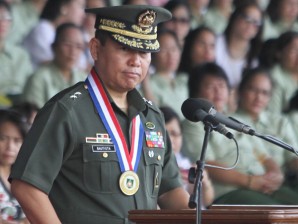‘‘I didn’t allow dad’s death to affect my decisions in Zamboanga siege’’
MANILA, Philippines–A son of a general who was killed by Moro National Liberation Front (MNLF) rebels in the late 1970s, Armed Forces of the Philippines chief General Emmanuel Bautista turned “low-key” when it was his turn to deal with the Moro rebels last month.
Bautista was a plebe or a freshman cadet at the Philippine Military Academy when his father, the late Brigadier General Teodulfo Bautista and 33 other officers and personnel were gunned down by MNLF rebels in Patikul, Sulu in 1977.
Organized in the 1970s, the MNLF is considered as the first group of Moro rebels to have sought secession from the Philippines.
MNLF Commander Usman Sali had then lured the senior Bautista, then Army’s First Infantry Division Commander, into a meeting in Patikul with a promise to talk about a ceasefire. The general showed up unarmed and was shot to death. Only one soldier survived the bloodbath.
“Personally, I did not allow that to cloud my decisions, and I did not want to be at the forefront [during the siege], if you noticed. I was very low-key,” he said Friday when asked if the Zamboanga City siege reminded him of his father’s tragic death.
Article continues after this advertisement“Deliberately kasi ayokong macolor yung actions namin dun, it did not affect at all my decision,” he said.
Article continues after this advertisementIt will be the 36th year after his father’s death on October 10.
The AFP chief said that the MNLF is still a friend of the government.
“We have a peace agreement with the MNLF. We only engaged with a small faction. We have two MNLF integrees in the Armed Forces and they fought on the side of the government. In fact two of them were killed in action,” he said.
“Most of them do not agree also with that plan,” he said of other MNLF factions.
The MNLF faction of Misuari launched its attacks on Sept. 9 which turned into a three-week gunbattle. It was not in favor of the government negotiating peace with the Moro Islamic Liberation Front (MILF), a breakaway group of the MNLF.
Even so, Bautista, a staunch advocate of peace as he headed the crafting of Internal Peace Security Plan Bayanihan, the military’s counterinsurgency plan that highlights a non-combat dimension, said he was “looking forward” to the peace agreement with the MILF.
“We look forward to the eventual signing of the peace agreement with the MILF and hopefully the other threat groups, we should be able to address as well. They always ask what the military would do, but the solution is in all of us. We have an advocacy and that this is a whole of nation approach,” he said.
Tribute to soldiers
Also on Friday, Bautista visited the soldiers who formed the main force that engaged the MNLF in the three-week standoff.
He trooped to Fort Magsaysay in Nueva Ecija, where soldiers of the Joint Special Operations Group stayed after getting a hero’s welcome in Manila on Wednesday.
The JSOG units that were deployed in Zamboanga include the Army Light Reaction Battalion, Navy Special Operations Unit-8 of the Philippine Navy Special Operations Group, and the Air Force Special Operations Wing.
“We visited our troops from Zamboanga City to give them honor and respect and to thank them for the heroism and bravery they demonstrated in Zamboanga,” he told reporters later at Camp Aguinaldo.
“Our main objective was to rescue the hostages. We rescued 195. Unfortunately two perished and seven were wounded. By any standards I think that is a good accomplishment,’’ he said.
“We also paid tribute to those who passed away and those who were wounded in action,” he added.
